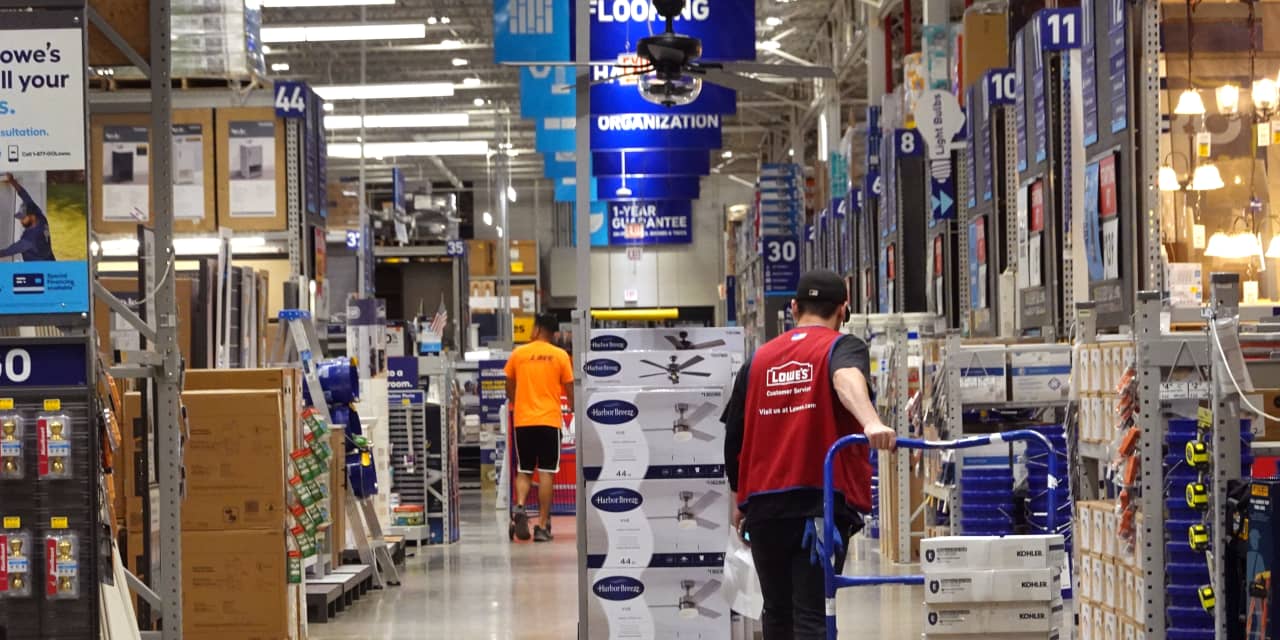Lowe’s
beat Wall Street’s fourth-quarter expectations, but the results confirm the home improvement sector hasn’t shaken off its monthslong slump.
The do-it-yourself retailer reported earnings per share of $1.77 on $18.6 billion in revenue, compared with a
FactSet
consensus for $1.68 a share and $18.5 billion. Comparable sales slipped 6.2% because of a slowdown in DIY demand, but the drop was less steep than estimates that called for a 7% decline.
”This quarter we delivered strong operating profit and improved customer satisfaction, despite the continued pullback in DIY spending,” said Marvin R. Ellison, Lowe’s CEO. “We remain confident in the long-term strength of the home improvement market.”
Guidance was weak, however, as the company believes DIY spending will remain under pressure throughout 2024. For the fiscal year, the company expects earnings of $12 to $12.30 a share, with revenue of $84 billion to $85 billion. Analysts surveyed by FactSet forecast full-year profit of $12.68 a share on revenue of $85.36 billion. Lowe’s expects fiscal-year comparable sales to fall 2% to 3%.
“We had warned of downside risk to the 2024 guidance, which we anticipated would be below consensus, reflecting a continuation of consumer-related headwinds on DIY,” wrote KeyBanc Capital Markets analyst Bradley Thomas, who has a Sector Weight rating on the stock and doesn’t have a price target.
Lowe’s was up 2% to $235.95 in midmorning trading Tuesday—suggesting Wall Street wasn’t too upset with the guidance, and perhaps had been bracing for even worse.
“We would rather see LOW guide to something makable than to set a high bar and need to guide down,” wrote D.A. Davidson analyst Michael Baker, who rates the stock a Buy. “Thus, although business trends may still be soft, we believe the stock should hold in well on a print that was no worse than expected.”
In a note last week, citing
Citi’s
credit card data, Citi analyst Steven Zaccone wrote: “On an annual basis, 2023 was the worst year for home improvement spending since the bursting of the housing bubble.”
The category came under pressure from several macroeconomic factors, including higher interest rates, low housing turnover, and softer consumer demand for durable goods, Zaccone noted, which resulted in fewer transactions and smaller basket sizes.
Those challenges were on display in Lowe’s and
Home Depot’s
lackluster earnings reports, and will continue constricting home improvement spending throughout 2024, the companies said.
Still, coming into the session, Lowe’s stock has gained 17% in the past three months, outstripping the S&P 500’s 11% gain.
Home Depot
shares are 20% higher. The rally was fueled by hopes that the home improvement sector’s rough patch could be coming to an end—but as Brandon Sink, Lowe’s chief financial officer, noted Tuesday, there will likely be a lag before sales start trending higher.
“There is optimism around potential interest rate cuts and improved consumer sentiment—however, the timing of [Federal Reserve] actions remains unclear, and there can be a lag before monetary policy impacts the consumer,” Sink said on a call with investors. “Also, housing turnover remains depressed and the consumer’s still showing a greater preference for spending on services rather than goods.”
The sector has gained a bull in Stephanie Link, Hightower Advisors’ chief investment strategist and portfolio manager.
“Clearly, they’re having the hangover of Covid, and I think that’s about to change,” she told Barron’s ahead of Lowe’s’ report.
And while Link is unclear about when that change is going to take place, she believes the sector could start to rebound by the end of this year.
Still, Link prefers Home Depot over Lowe’s, adding to her position in Home Depot.
“When you can get the number one company in any given industry on sale, you buy it,” she said. “I’m not saying you don’t want to look at Lowe’s. I think Marvin [Ellison] is doing an amazing job, and it’s a heck of a lot cheaper, but, I think, that’s for a reason.”
Write to Sabrina Escobar at [email protected]
Read the full article here




